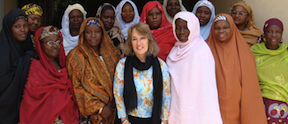 Recent data from the Treatment Episode Data Set reveal that 4.8% of female substance abuse admissions (between the ages of 15 to 44) are pregnant at the time of entry. While this percentage has remained fairly stable since 2000, the percentage of these pregnant women reporting drug abuse has increased to 63.8%, an increase of almost 13% since 2000. Non-pregnant female admissions in the same age range reveal a similar pattern for drug use, while percentages for both groups reporting alcohol abuse has decreased. The report published by the Substance Abuse and Mental Health Services Administration (SAMHSA) writes that these trends “may highlight the need to focus greater attention on addressing drug abuse among this population.”
Recent data from the Treatment Episode Data Set reveal that 4.8% of female substance abuse admissions (between the ages of 15 to 44) are pregnant at the time of entry. While this percentage has remained fairly stable since 2000, the percentage of these pregnant women reporting drug abuse has increased to 63.8%, an increase of almost 13% since 2000. Non-pregnant female admissions in the same age range reveal a similar pattern for drug use, while percentages for both groups reporting alcohol abuse has decreased. The report published by the Substance Abuse and Mental Health Services Administration (SAMHSA) writes that these trends “may highlight the need to focus greater attention on addressing drug abuse among this population.”
Any substance abuse by pregnant women can result in miscarriage or premature birth, as well as a plethora of other health-related and developmental problems for the baby and mother both. In light of these recent trends, it is clear more educational outreaches must be available to prevent this statistic from climbing any higher. SAMHSA Administrator Pamela S. Hyde calls for increased access to “prevention, support, and recovery services” that meet the specialized need of pregnant and postpartum women. SAMHSA’s already active Residential Treatment Program for Pregnant and Postpartum Women is a step in the right direction. This program encompasses comprehensive residential treatment and educates women on prevention, treatment, and recovery. Furthermore, the family-centered approach they take strengthens relationships beyond the substance users to encompass all affected victims. More programs modeled after the SAMHA platform would improve the education and prevention of life-threatening abuses to women across the globe.
Please click here to review the full report.

 Do you have questions about menopause? Are you ever curious about hormone therapy treatments? You’re not alone! Every year over two million women in America alone enter into menopause, and most have questions. The Women’s Health Research Institute wants to provide answers with the creation of a new website:
Do you have questions about menopause? Are you ever curious about hormone therapy treatments? You’re not alone! Every year over two million women in America alone enter into menopause, and most have questions. The Women’s Health Research Institute wants to provide answers with the creation of a new website:  Surfacing research proves the Sub-Saharan African traditions of Female Genital Mutilation and Female Genital Cutting (FGM/FGC) lead to long-term health consequences. Such health problems are found to impact the delivery and health of newborns. Researchers and anthropologists from the Autonomus University of Barcelona collected data from 588 females in The Gambia. Data were carefully gathered through questionnaires and physical examinations of the female patients, and analyzed with 95% confidence intervals. The results showed that 75.6% of the women had undergone FGM or FGC, and these women had a significantly higher prevalence of health problems including dysmenorrhea, vulvar or vaginal pain, fibrosis, keloid, synechia, and sexual dysfunction. Furthermore, research showed these women were four times more likely to experience delivery complications such as perineal tear, obstructed labor, episiotomy, cesarean-necessitated delivery, and stillbirth.
Surfacing research proves the Sub-Saharan African traditions of Female Genital Mutilation and Female Genital Cutting (FGM/FGC) lead to long-term health consequences. Such health problems are found to impact the delivery and health of newborns. Researchers and anthropologists from the Autonomus University of Barcelona collected data from 588 females in The Gambia. Data were carefully gathered through questionnaires and physical examinations of the female patients, and analyzed with 95% confidence intervals. The results showed that 75.6% of the women had undergone FGM or FGC, and these women had a significantly higher prevalence of health problems including dysmenorrhea, vulvar or vaginal pain, fibrosis, keloid, synechia, and sexual dysfunction. Furthermore, research showed these women were four times more likely to experience delivery complications such as perineal tear, obstructed labor, episiotomy, cesarean-necessitated delivery, and stillbirth. The pro-life v. pro-choice debate continued on the House floor yesterday as party representatives grappled with sustaining women’s reproductive rights in a surfacing abortion bill. On Tuesday, the House of Representatives approved a bill banning a woman’s right to pursue an abortion after 22 weeks of pregnancy, subtracting two weeks off the current cut-off of abortions at 24 weeks in utero. The majority-Republican party passed this bill shaving off the extra two weeks based off the medically disputed theory that a fetus is capable of feeling pain 20 weeks after conception (which is equivalent to 22 weeks of pregnancy). Democrats in the House and the White House fought against the bill, saying the legislation is an “assault on a woman’s right to choose” and is an attempt to undermine the precedent set in the 1973
The pro-life v. pro-choice debate continued on the House floor yesterday as party representatives grappled with sustaining women’s reproductive rights in a surfacing abortion bill. On Tuesday, the House of Representatives approved a bill banning a woman’s right to pursue an abortion after 22 weeks of pregnancy, subtracting two weeks off the current cut-off of abortions at 24 weeks in utero. The majority-Republican party passed this bill shaving off the extra two weeks based off the medically disputed theory that a fetus is capable of feeling pain 20 weeks after conception (which is equivalent to 22 weeks of pregnancy). Democrats in the House and the White House fought against the bill, saying the legislation is an “assault on a woman’s right to choose” and is an attempt to undermine the precedent set in the 1973  Geneticists, researchers, and patients joined in celebration over last week’s unanimous Supreme Court ruling involving the BRCA1 and BRCA2 genes, colloquially referred to as the “breast cancer genes.” The Supreme Court ruled that Myriad Genetics could not patent the BRCA1 and BRCA2 sequence of genes, because patents cannot be placed on that which is created organically in nature. This decision opens the door for researchers outside of Myriad Genetics to study these genes, providing more opportunities to discover early signs of breast cancer susceptibility. Karuna Jaggar, Breast Cancer Action’s Executive Director reported that this ruling was, “a tremendous victory for women with a known or suspected inherited risk of breast cancer. Today, the Court righted a wrong and has put patients’ health before corporate profits.”
Geneticists, researchers, and patients joined in celebration over last week’s unanimous Supreme Court ruling involving the BRCA1 and BRCA2 genes, colloquially referred to as the “breast cancer genes.” The Supreme Court ruled that Myriad Genetics could not patent the BRCA1 and BRCA2 sequence of genes, because patents cannot be placed on that which is created organically in nature. This decision opens the door for researchers outside of Myriad Genetics to study these genes, providing more opportunities to discover early signs of breast cancer susceptibility. Karuna Jaggar, Breast Cancer Action’s Executive Director reported that this ruling was, “a tremendous victory for women with a known or suspected inherited risk of breast cancer. Today, the Court righted a wrong and has put patients’ health before corporate profits.” Policy changes are necessary to decrease the death rate of pregnant women in developing countries. Research, according to Dr. Stacie E. Geller, does not end once scientists publish. The true battle is implementing that research to affect global change. Dr. Stacie E. Geller, Director of the Center for Research on Women and Gender at the University of Illinois at Chicago College of Medicine, puts research into practice by providing safe, affordable medication to pregnant women in developing countries. Dr. Geller spoke last week at a forum held at Northwestern University's Feinberg School of Medicine and presented her research on Postpartum Hemorrhaging (PPH) and its dangers to women in developing countries.
Policy changes are necessary to decrease the death rate of pregnant women in developing countries. Research, according to Dr. Stacie E. Geller, does not end once scientists publish. The true battle is implementing that research to affect global change. Dr. Stacie E. Geller, Director of the Center for Research on Women and Gender at the University of Illinois at Chicago College of Medicine, puts research into practice by providing safe, affordable medication to pregnant women in developing countries. Dr. Geller spoke last week at a forum held at Northwestern University's Feinberg School of Medicine and presented her research on Postpartum Hemorrhaging (PPH) and its dangers to women in developing countries. Think men and women receive equal care after traumas? Think again. A recent study found that women are less likely than men to receive trauma treatment after severe injuries. Dr. Andrea Hill of the Sunnybrook Health Sciences Centre and the University of Toronto’s research on gender-based inequalities found that, across all age groups, 20-30% fewer women are cared for after traumas. The study and analysis were conducted by observing 99,000 adult patients throughout Canada. After controlling for demographic and socioeconomic factors, Hill and her colleagues were shocked at such disproportions between male and female patient care. Hill affirms that “gender-based disparities in access to health care services in general have been recognized for some time,” and she calls for further research into the underlying factors involved in these gender gaps.
Think men and women receive equal care after traumas? Think again. A recent study found that women are less likely than men to receive trauma treatment after severe injuries. Dr. Andrea Hill of the Sunnybrook Health Sciences Centre and the University of Toronto’s research on gender-based inequalities found that, across all age groups, 20-30% fewer women are cared for after traumas. The study and analysis were conducted by observing 99,000 adult patients throughout Canada. After controlling for demographic and socioeconomic factors, Hill and her colleagues were shocked at such disproportions between male and female patient care. Hill affirms that “gender-based disparities in access to health care services in general have been recognized for some time,” and she calls for further research into the underlying factors involved in these gender gaps. Did you know that 15% of women are diagnosed with Hypoactive Sexual-Desire Disorder (
Did you know that 15% of women are diagnosed with Hypoactive Sexual-Desire Disorder ( On Tuesday, December 18th the
On Tuesday, December 18th the  Carol Marin Accepting Voice for Women Award
Carol Marin Accepting Voice for Women Award